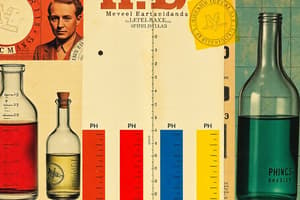Podcast
Questions and Answers
What are indicators and how do they function in relation to pH?
What are indicators and how do they function in relation to pH?
Indicators are weak organic compounds that change color according to the pH of the solution, dissociating slightly to respond to hydrogen ion concentration.
Define the pH scale and its significance in chemistry.
Define the pH scale and its significance in chemistry.
The pH scale ranges from 0 to 14 and indicates the strength of acids (pH < 7) and bases (pH > 7), with 7 being neutral.
What is the mathematical definition of pH?
What is the mathematical definition of pH?
pH is defined as the negative logarithm of the hydrogen ion concentration, expressed as pH = -log10[H+].
How does adding an acid affect the concentration of H+ and OH- ions in a solution?
How does adding an acid affect the concentration of H+ and OH- ions in a solution?
What is the value of the ionic product of water at 25°C?
What is the value of the ionic product of water at 25°C?
List three indicators and their corresponding pH values.
List three indicators and their corresponding pH values.
Explain what happens to the pH and ion concentrations during a neutralization reaction.
Explain what happens to the pH and ion concentrations during a neutralization reaction.
What is the phenomenon observed when pH changes in a solution with an indicator?
What is the phenomenon observed when pH changes in a solution with an indicator?
What characterizes a solution with a pH of less than 7?
What characterizes a solution with a pH of less than 7?
Describe the role of hydrolysis in determining pH in aqueous solutions.
Describe the role of hydrolysis in determining pH in aqueous solutions.
Flashcards are hidden until you start studying
Study Notes
Indicators
- Weak organic compounds that function as acids or bases.
- Change color based on the pH of the solution.
- Dissociate slightly in solution to produce ions and undissociated molecules.
- The color change is dependent on hydrogen ion concentration (pH).
pH Value of a Medium
- Pure water is neutral, yielding equal amounts of H+ and OH- ions.
- At 25°C, [H+] and [OH-] equal 10⁻⁷ mol.dm⁻³.
- Ionic product of water (Kw) is 10⁻¹⁴ at 25°C, calculated as Kw = [H+][OH-].
- Adding an acid increases [H+] concentration above 10⁻⁷, while decreasing [OH-].
- pH measures the strength of acids and bases, with a formula: pH = -log₁₀[H+].
- pH scale:
- pH 7 = neutral
- pH < 7 = acidic
- pH > 7 = basic
Determination of pH by Use of Indicators
- Common acid-base indicators have specific color changes at various H+ concentrations:
- pH 1: Litmus solution red (H+ = 10⁻¹)
- pH 2: Methyl orange pink (H+ = 10⁻²)
- pH 7: Neutral (no specific indicator)
- pH 9: Litmus solution blue (H+ = 10⁻⁹)
- pH 10: Methyl orange yellow (H+ = 10⁻¹⁰)
- pH 13: Phenolphthalein pink (H+ = 10⁻¹³)
pH Scale
- A numerical scale indicating the relative strength of acids and bases.
Common Examples of Indicators
- Phenolphthalein functions as an acid-base indicator, changing color based on pH.
Utility of Indicators
- Indicators can identify acidity or alkalinity based on color change.
- They help quantify the strength of acids and bases within solutions.
- Indicators are essential tools in various chemical analyses.
Studying That Suits You
Use AI to generate personalized quizzes and flashcards to suit your learning preferences.




